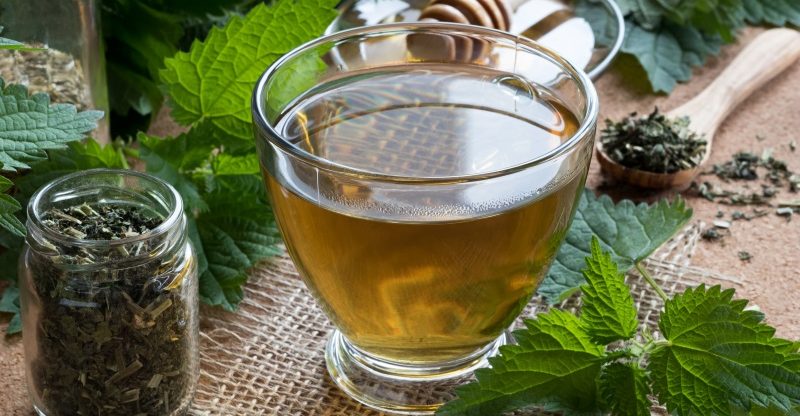11 Evidence-Based Benefits of Stinging Nettle
Once you get past the scary name, stinging nettle is actually a very beneficial plant that can help treat many conditions and health problems.
If you are interested in learning more about how it reduces inflammation and treats several medical conditions, we have compiled this guide to help demystify this funky plant, so that you can enjoy the benefits, without worrying about the risks.
Stinging nettle has been around for thousands of years, but we are just now starting to understand the scientific reasons why the herb is so good for our health.
Understanding Stinging Nettle
The Urtica dioica, or stinging nettle plant, is native to many parts of the world, including North America, Africa, Asia and Europe (1).
The herb is a perennial flowering plant, whose medicinal uses date back to the ancient Greeks.
Its name is derived from the reaction your skin gets from touching the plant, which includes skin irritation that stings.
Once the plant is cooked or processed correctly, however, this reaction ceases, and you can enjoy all the benefits this herb has to offer.
In addition to using it as medicine, stinging nettle has long been used to create fabrics, cosmetics, and food (2).
Its healing uses have included the relief of nasal congestion, support of joint health and the enhancement of male vitality.
In addition to being an herbal remedy, stinging nettle fibers can be used to make cloth and paper.
The fibers of this plant are similar to flax and hemp, making it a sustainable alternative to other fiber sources.
During World War I, the German army used it to make uniforms, and its leaves were used to dye clothing during World War II.
While most products today are made from the leaves or stems of the stinging nettle plant, the roots also have properties that can improve your health.
This plant is a strong anti-inflammatory, which can improve many different medical conditions.
It is also an effective treatment for seasonal allergies, as well as bladder problems and respiratory issues.
Nutrition and Bioactive Components
The healing properties that are found in stinging nettles come from the bioactive compounds that are found in this plant.
It has several potent antioxidants, including quercetin, rutin, kaempferol, quinic acid, caffeic acid, and choline.
Stinging nettle also contains lecithin, an essential fatty acid that is necessary for good health.
The roots of this plant also contain fatty acids, plant sterols, scopoletin, secoisolariciresinol, and vanillin, which are not found in the leaves.
Stinging nettle is also an excellent source of protein, Vitamins A, B1, and K, as well as iron, calcium, and potassium.
How to Take Stinging Nettle
You can now purchase stinging nettle supplements and products in a variety of forms.
It can be found in tea, as capsules or tinctures, in loose leaves or dried roots, and in creams or gels.
You can also harvest wild stinging nettle yourself, which we explore more below.
The typical dosage for stinging nettle is around 450 milligrams of dry root extract per day.
If you are taking leaf extracts, you can take anywhere between 275 milligrams and two grams per day.
You want to purchase products that contain the right part of the stinging nettle plant for your ailment.
Some conditions respond better to root extracts, while others do better with leaf compounds.
Some health conditions benefit from lower dosages, so check the product label or with your doctor, if you are unsure how much you should be taking.
Some popular ways to take stinging nettle include:
- Nettle tea – Dried leaves and flowers are steeped into a tea. Commercial teas will often mix stinging nettle with other herbs, including goldenseal, echinacea, and raspberry leaf.
- Cooked nettles – Nearly the entire nettle plant is edible, and once prepared, is quite tasty, resembling spinach in its flavor. The young leaves are the best. Making soup or stew with this plant results in a nutritious and tasty treat. You can also puree cooked plants to create sauces, dressings, or to add to smoothies. You should never eat raw nettles.
- Topical applications – The liquid tinctures and extracts are good for applying to sore joints and to relieve muscle pain. It can also be added to creams or lotions.
- Tablets or capsules – The dried compounds of this plant are available in easy-to-take pills that allow you to enjoy the benefits regularly. You may want to take these with food if they upset your stomach.
How to Handle Wild Plants
If you want to harvest stinging nettle in the wild, you must first be able to identify the plant.
The next step is to learn how to properly handle it to avoid the skin irritation from which it gets its name.
Stinging nettle usually grows between two and four feet high, and it is known to bloom throughout the summer months.
It produces pink or yellow flowers, with heart-shaped leaves.
The leaves and stems are covered with exceptionally fine hairs, that create a stinging or burning reaction when they come into contact with skin.
These hairs are called trichomes.
They will pierce your skin and inject a fluid into your body that contains histamine, acetylcholine, and formic acid, which all create inflammation.
The formic acid will actually cause the pain, which is similar to what you feel with an insect bite or sting (3).
It is only once the plant is cooked or dried, that these hairs lose their stinging abilities and the plant can be safely consumed.
If you want to harvest wild stinging nettle, you must wear sturdy gloves while touching the plant.
The process of drying or cooking deactivates the formic acid, which allows you to enjoy the plant without the harsh reaction.
Treating a Stinging Nettle Sting
If you do get stung by the trichomes while handing a stinging nettle plant, do not scratch or otherwise touch this area.
You can spread the irritants that are causing the burning to other parts of your body or deeper into your skin.
As quickly as you can, wash the area thoroughly with water and soap.
If you think you have hairs stuck in your skin, you can remove them using duct tape.
Once you have cleansed the area, you can apply traditional anti-itch treatments, like cortisone, aloe vera, or cold compresses to ease your discomfort.
Stinging Nettle Health Benefits
Stinging nettle has been used for centuries to treat many different medical problems.
As a result, there is a great deal of anecdotal evidence of its effectiveness.
More recent medical research on this plant is also providing additional insight.
Most of the studies have involved cell studies or animal trials.
Therefore, you should use caution when applying these results to human reactions.
It is also important to note that not all parts of the stinging nettle plant have the same reactions or benefits.
Just there is a benefit from using one part of the plant, does not mean that there will be the same benefit from other parts of the plant.
Lowers Inflammation
There are several ways that the stinging nettle plant can lower inflammation and reduce pain in the body.
Extracts from stinging nettle leaves have been shown to reduce inflammation, by blocking pro-inflammatory markers in the blood, like TNF-a, IL-1, IL-6, and NF-kB (4, 5).
It is also effective at inhibiting leukocyte elastase, which is an enzyme that increases inflammation (6).
When taken with anti-inflammatory medications, stinging nettle leaf extract improved the effects of the drug for patients with arthritis (7).
In animal trials, extract from stinging nettle leaves also reduce inflammation (8).
Inflammation leads to many chronic illnesses, including osteoarthritis.
Taking stinging nettle could help reduce arthritis symptoms and provide a better quality of life to sufferers.
In one study, patients received a combination of supplements that included stinging nettle and devil’s claw.
They showed reduced pain and inflammation, compared to the placebo group (9).
This is likely due to stinging nettle’s ability to stop the activation of various inflammatory markers and compounds, which are often overactive in those with arthritis (10).
One ancient treatment for arthritis that is not necessarily recommended today is to apply raw nettle leaves or stems to arthritic areas to generate inflammation, which over time can reduce chronic rheumatism (11).
Using stinging nettles in this way can result in a severe allergic reaction.
Therefore, it is not now recommended for use by most medical professionals.
Using stinging nettles in conjunction with other, traditional treatments for arthritis can bring more relief to sufferers.
Nettles help to enhance the anti-inflammatory properties of medications like NSAIDs, which can allow patients to take less medication, while still enjoying relief (12).
Adding nettle extract to creams or gels, then applying this topically to arthritic joints or painful areas can also provide relief.
This has been an effective treatment for generations in many communities.
Can Reduce Allergies
For those who suffer from chronic or seasonal allergies, finding relief can help improve their lives while decreasing their symptoms.
Stinging nettle could be the answer to your allergy symptoms.
The extract from stinging nettle leaves helps to reduce histamine production while inhibiting inflammatory markers.
It, therefore, also leads to reduced allergy symptoms overall (13).
These results have been seen in the use of freeze-dried leaves, as well as from drinking nettle tea (14, 15).
In one study, nearly half of the patients who were treated with stinging nettles reported that the treatment was better than their conventional allergy medication (16).
In cell studies, extracts from this plant were also shown to effectively block the inflammation that triggers seasonal allergies like hay fever (17).
More research is needed to understand the specific mechanism by which this plant works and what dosages are best for treating various types of allergies.
Could Improve Prostate Health
One of the best benefits of stinging nettle for the body is to help improve prostate health in men.
It is particularly helpful in treating a condition known as benign prostatic hyperplasia or BPH, which causes the prostate to become enlarged.
The primary cause of BPH is age, and it can result in unpleasant symptoms such as difficulty urinating and sexual dysfunction (18).
Stinging nettle is now a popular and effective natural treatment for relieving an enlarged prostate.
It is preferred by many people because it has few side effects (19).
Several clinical trials have confirmed these results, including one study of 246 patients (20) and another with 558 patients (21).
Patients in these trials saw relief from inflammation, better urine flow, improved urine volume and decreased prostate size.
Additional research combining stinging nettle and saw palmetto showed that patients had superior results and tolerated the treatment better than prescription medications traditionally used to treat BPH (22).
Animal trials have also confirmed these results (23).
It is important to note that the compounds that are effective at treating BPH are found in the root of the stinging nettle plant, not the stem or leaves.
Can Treat Eczema
Eczema is a skin condition that is caused by excess inflammation.
It results in dry, itchy skin that can linger for extended periods.
One way to treat eczema effectively is to reduce the inflammation that causes the flareup.
Stinging nettles could be an effective treatment option.
This was shown by recent research that involved a two-pronged approach to treating the skin disorder.
Patients were given cream to treat the rash externally and also took nettle extract internally to reduce inflammation.
The results were successful (24).
Could Boost Testosterone Levels
Testosterone can be found in more than one form in the body.
When testosterone is bound to sex hormone binding globulin or SHBG, it becomes unusable.
Free testosterone is unbound and remains readily available for the body to use in various ways (25).
Lignans, which are substances found in stinging nettles and other plants, bind to SHBG, leaving less of it in the blood to bind to testosterone (26).
When you take stinging nettle, you can increase your available free testosterone, by decreasing the available SHBG (27).
This does not raise your total testosterone level, just what is designated as “free” within the blood for use.
Some evidence also suggests that the compounds in stinging nettle, when combined with saw palmetto, also block testosterone from being converted to estrogen (28).
Can Reduce Blood Glucose Levels
The compounds found in the leaves and stems of stinging nettles could help to reduce blood glucose levels and treat diabetes.
These chemicals are known to trigger the release of insulin, which effectively reduces blood sugar (29).
In one study, participants taking stinging nettle extract experienced decreased fasting blood sugar levels (30).
This was also confirmed in animal trials (31).
By increasing blood sugar balance, stinging nettle can also improve insulin resistance and help prevent the development of Type 2 diabetes (32).
Could Treat Hypertension
Hypertension or high blood pressure is a condition that affects nearly one in three people in the United States (33).
This serious health condition increases your risk of developing heart disease and for having a heart attack or stroke (34).
One of the traditional uses for stinging nettle is to lower blood pressure, making it a possible treatment for chronic hypertension.
The ability of stinging nettle to lower blood pressure has been documented in numerous clinical and animal trials.
This plant is known to stimulate the production of nitric oxide.
This naturally relaxes the muscles in the blood vessels, keeping them wide and decreasing blood pressure (35).
The compounds in this plant also act as calcium channel blockers in the body, which relax heart muscles and reduce the force necessary to pump your heart effectively (36).
This effect was confirmed in animal trials (37).
More research is needed to fully understand the effects of stinging nettle on the human heart.
Additional clinical research can help to illuminate how this plant could be used to effectively treat hypertension in the future.
Could Improve Wound Healing
A stinging nettle leaf extract may be able to improve healing of burns and scar tissue on the skin.
In animal trials, this extract enhanced the quality of healing for second-degree burns, when applied directly to the skin.
It accelerated healing time, while also reducing scarring more effectively (38).
In limited clinical trials, similar results have been achieved when combined with arnica gel (39).
Stinging Nettle Is a Diuretic
Your body relies on your kidneys to flush out toxins and wastes through proper urine production.
Diuretics are medications that can increase the production of urine and ensure that excess waste, salt, and water are effectively removed from the body.
The stems and leaves of the stinging nettle plant act as a natural diuretic (40).
When you are able to flush excess sodium from your body, you can effectively reduce your blood pressure (41).
Additional reasons you may need a diuretic, include poor kidney function and bloating due to other medical conditions.
As a diuretic, stinging nettle could also help to treat urinary tract infections and help you pass kidney stones.
The compounds in stinging nettle can effectively break down kidney stones, which makes it easier to pass and be flushed from the body (42).
Additional Benefits of Stinging Nettle
In addition to these benefits, there is some evidence to suggest stinging nettle can also help improve your health in other ways, including:
- Reduce excess bleeding- the extract from stinging nettle lowered bleeding after surgery (43).
- Improve liver health- the antioxidants in stinging nettles could protect your liver from toxicity and damage from inflammation and heavy metals (44).
Precautions
Because stinging nettle can increase the levels of free testosterone in the body, it can worsen conditions that are caused by excess levels of this hormone, such as polycystic ovary syndrome (45).
Women who are pregnant should avoid using stinging nettle since it can cause uterine contractions.
This could result in a miscarriage or pre-term labor, so you should exercise caution (46).
It is never recommended that you use raw stinging nettle in any application.
When applied to the skin, it can generate an allergic reaction, and when eaten without cooking or drying, it can create an internal allergic reaction that could be severe (47).
If you take drugs for high blood pressure or diabetes, stinging nettle may increase their effectiveness, by lowering levels too far (48, 49).
Some drugs are affected by metabolic enzymes in the CYP1A family.
Stinging nettle contains active compounds that naturally increase the effectiveness of these enzymes, which could lead to an increase in the effects of these medications.
Drugs of concern include blood thinners, stimulants, and melatonin and others (50).
In addition to increasing the effectiveness of prescription medications, stinging nettle can also enhance the effects of non-steroidal anti-inflammatory drugs or NSAIDs (51).
You should always talk with your doctor about combining other medicines with stinging nettle supplements.
Conclusion
Stinging nettle is a popular weapon in the herbal medicine arsenal of Western cultures.
It has been shown to be effective at lowering inflammation and blood pressure, as well as blood sugar levels.
It can also be used to treat seasonal allergies naturally.
While you may be wary of trying stinging nettle because it can hurt to harvest the plant naturally, you should not be concerned when using processed, dried, or cooked plants, which pose no threat.
Stinging nettle can be purchased in a wide array of products that allow you to enjoy its benefits without the hassle.
However, eating stinging nettle is also an excellent way to enjoy this plant’s many advantages.
Nettle soup and tea are favorite ways to consume this healing herb.
If you want to protect your bones, skin, urinary health, or heart, then stinging nettle is an excellent choice for you.
Consider how stinging nettle could lower your inflammation and help you treat the conditions and symptoms that are associated with this immune system response.
You will soon see why so many rely on its benefits.
FDA Compliance
The information on this website has not been evaluated by the Food & Drug Administration or any other medical body. We do not aim to diagnose, treat, cure or prevent any illness or disease. Information is shared for educational purposes only. You must consult your doctor before acting on any content on this website, especially if you are pregnant, nursing, taking medication, or have a medical condition.
HOW WOULD YOU RATE THIS ARTICLE?





